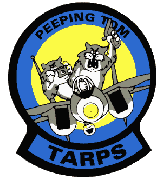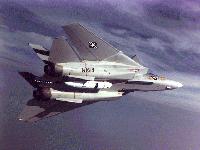


TARPS (Tactical Airborne Reconnaissance Pod System)
 The TARPS (Tactical Airborne Reconnaissance Pod System) is carried on the F-14 Tomcat. The 17-foot, 1,850-pound gray pod is actually a protective aluminum case manufactured by Grumman. Inside its shell, three camera sensors are mounted in sturdy equipment racks. They aim down at passing terrain, using infrared to capture images at night. In the air, the aluminum pod protects the cameras from vibrations and soaking by hydraulic fluid and JP-5 jet fuel. It
must withstand buffeting by winds at twice the speed of sound. When a Tomcat returns from a reconnaissance mission, the pod is opened and film is rushed to processing. The
shipboard record for processing turnaround, from landing to finished print, is 13 minutes. 3,350 feet of new film is placed in the pod, and it is ready to go again.
The TARPS (Tactical Airborne Reconnaissance Pod System) is carried on the F-14 Tomcat. The 17-foot, 1,850-pound gray pod is actually a protective aluminum case manufactured by Grumman. Inside its shell, three camera sensors are mounted in sturdy equipment racks. They aim down at passing terrain, using infrared to capture images at night. In the air, the aluminum pod protects the cameras from vibrations and soaking by hydraulic fluid and JP-5 jet fuel. It
must withstand buffeting by winds at twice the speed of sound. When a Tomcat returns from a reconnaissance mission, the pod is opened and film is rushed to processing. The
shipboard record for processing turnaround, from landing to finished print, is 13 minutes. 3,350 feet of new film is placed in the pod, and it is ready to go again.
The front of the pod carries is a two-position (vertical and forward oblique) KS-87 frame camera. Aft of the frame camera is a KA-99 low-altitude panoramic camera, followed by a AAD-5 imaging infrared sensor. The pod is carried on the F-14's #5 weapon station (the right rear Phoenix station). F-14 TARPS remains the fleet's primary organic recce asset, and continues to respond to USMC, SOF (Special Operating Forces), and JFACC (Joint Forces Air Component Commander) requirements.
Since the early 1980s F-14s have had provision for the attachment of the Tactical Air Reconnaissance Pod System (TARPS), carrying optical and infrared cameras and permitting the aircraft to perform the photo reconnaissance role without degrading its performance in other roles. The only modifications required are wiring changes and cockpit readouts. In 1989, the Navy decided to phase out the F-14's reconnaissance mission in favor of using F/A-18 Hornets.
During Operation Desert Storm in January-February 1991, however, F-14s flew 781 TARPS missions.

Beginning in April 1993, the Navy has flown many F-14 Tactical Aerial Reconnaissance Pod (TARPS) sorties over Bosnia-Hercegovina as part of Operation Deny Flight. Operating from aircraft carriers stationed in the Adriatic Sea, the TARPS aircraft photographed hundreds of square miles of disputed territory, using thousands of feet of film. After the aircraft recovered aboard the carrier, Intelligence Specialists provided the commander and other senior decisionmakers the location and types of belligerent arms, equipment, and forces. The Intelligence Specialists also produced annotated TARPS photos for carrier and shore-based strike team leaders to assist in planning potential contingency operations. Navy F-14 TARPS provided the only U.S. tactical reconnaissance asset over Bosnia, thus providing an invaluable service to the European Command who were able to show the unclassified TARPS pictures to the international press.

Units also responded to the Mississippi River Valley caused by record rainfalls in July 1993. In a two-day mission requested by the Federal
Emergency Management Agency, two Navy F-14 Tomcat fighters based at
Naval Air Station Oceana (from Fighter Squadron 103 and Fighter
Squadron 143) flew reconnaissance missions over the St. Louis, Mo.,
area. The fighters, equipped with Tactical Air Reconnaissance Pod
System (TARPS) cameras, flew additional missions over cities in
Iowa. The TARPS photography will enable rescue and relief workers
to determine the hardest-hit areas, helping to identify areas
requiring assistance.
TARPS pods are routinely carried under the fuselage of F-14D Tomcat fighter jets as they fly Operation Southern Watch missions, enforcing the United Nations-sanctioned "no-fly" zone over Southern Iraq. The heat of the Arabian Gulf, where average noon temperatures hover in the high 90s, can cause some simple equipment problems. When film is moved from an air conditioned area out to the flight deck it can fog, jam, or adhere to
surfaces around it. Film transport and shuttle speeds are also simple fixes. But other "glitches" are more challenging, requiring circuit card troubleshooting.
GENSER JDISS (Joint Deployable Intelligence Support System) and high quality digitizers have been used to send tactical reconnaissance imagery acquired by F-14 TARPS to recipients in soft copy in near-real time. This capability eliminated the requirement to make multiple hard copies in the photo lab and fly them off to a shore site for further distribution.
The TARPS digital imagery (DI) electro-optical (EO) improvement represents an interim, but limited, capability. However, there is a need to move to a production EO
capability with a larger format backplane that provides both
better resolution and a larger target area field-of-view. The TARPS CD development would provide such a capability at significantly less cost than a Navy purchase of
the Advanced Tactical Airborne Reconnaissance System (ATARS).
Based on the successful results from the interim DI
efforts, CD will provide an EO tactical manned reconnaissance capability to
replace the current film-based F-14 pods. The Navy plans to build 24 Tactical Air Reconnaissance Pod System-Digital Imagery (TARPS-DI) pods by 2003 at a cost of
between $6-8 million. One of the principal uses for TARPS-DI will be to
locate and identify hostile targets so they can be quickly
neutralized by aircraft, cruise missile or naval gunfire
strikes. Each image displays the latitude and longitude of the location photographed. That information would be invaluable in a combat situation.
The advantages of TARPS imagery over satellite reconnaissance is that the satellites make one pass over an area, and have to be reprogrammed. With new TARPS digital imagery, anything a jet with a pod ‘sees’ can be sent back by radio signal. Specialists can interpret the images and use it almost immediately, and can send the pilot back for another look.
The Navy's 211 F-14As are due to be phased out of service by
2004. Of the 13 existing F-14A squadrons, six are at Miramar and
seven are at Naval Air Station Oceana, VA. The Navy's four F-14D
Super Tomcat squadrons were all based at NAS Miramar, CA. Miramar based
squadrons are currently moving to Oceana. By 1 October 1997, NAS Miramar will transition to MCAS Miramar. The F-14D, which rolled off the production line in the early 90s, has upgraded avionics and a more powerful engine.
TARPS Squadrons |
|---|
| Squadron | Assignment | Aircraft |
|---|
|
VF-2 | Bounty Hunters | CVW-2 | USS Constellation (CV-64) | F-14D
|
|
VF-31 | Tomcatters | CVW-14 | USS Abraham Lincoln (CVN-72) | F-14D
|
|
VF-32 | Swordsmen | CVW-3 | USS Theodore Roosevelt (CVN-71) | F-14A
|
|
VF-41 | Black Aces | CVW-8 | USS John F. Kennedy (CV-67) | F-14A
|
|
VF-102 | Diamondbacks | CVW-1 | USS George Washington (CVN-73) | F-14B
|
|
VF-103 | Jolly Rogers [ex Sluggers] | CVW-17 | USS Enterprise (CVN-65) | F-14B
|
|
VF-143 | Pukin' Dogs | CVW-7 | USS John C. Stennis (CVN-74) | F-14B
|
|
VF-154 | Black Knights | CVW-5 | USS Independence (CV-62) | F-14A
|
|
VF-201 | Hunters | CVWR-20 | Naval Air Reserve no carrier | F-14A
|
|
VF-202 | Superheats | CVWR-20 | Naval Air Reserve | F-14A
|
|
VF-211 | Checkmates | CVW-9 | USS Nimitz (CVN-68) | F-14A
|
|
VF-213 | Black Lions | CVW-11 | USS Kitty Hawk (CV-63) | F-14A
|
| SOURCE: Tomcat's Lair Current Status of F-14 Squadrons |
Sources and Methods
https://fas.org/irp/program/collect/tarps.htm
Maintained by Steven Aftergood
Created by John Pike
Updated Friday, November 06, 1998 11:41:41 AM
 The TARPS (Tactical Airborne Reconnaissance Pod System) is carried on the F-14 Tomcat. The 17-foot, 1,850-pound gray pod is actually a protective aluminum case manufactured by Grumman. Inside its shell, three camera sensors are mounted in sturdy equipment racks. They aim down at passing terrain, using infrared to capture images at night. In the air, the aluminum pod protects the cameras from vibrations and soaking by hydraulic fluid and JP-5 jet fuel. It
must withstand buffeting by winds at twice the speed of sound. When a Tomcat returns from a reconnaissance mission, the pod is opened and film is rushed to processing. The
shipboard record for processing turnaround, from landing to finished print, is 13 minutes. 3,350 feet of new film is placed in the pod, and it is ready to go again.
The TARPS (Tactical Airborne Reconnaissance Pod System) is carried on the F-14 Tomcat. The 17-foot, 1,850-pound gray pod is actually a protective aluminum case manufactured by Grumman. Inside its shell, three camera sensors are mounted in sturdy equipment racks. They aim down at passing terrain, using infrared to capture images at night. In the air, the aluminum pod protects the cameras from vibrations and soaking by hydraulic fluid and JP-5 jet fuel. It
must withstand buffeting by winds at twice the speed of sound. When a Tomcat returns from a reconnaissance mission, the pod is opened and film is rushed to processing. The
shipboard record for processing turnaround, from landing to finished print, is 13 minutes. 3,350 feet of new film is placed in the pod, and it is ready to go again.




